Clare Castle, Seat Of Elizabeth De Clare Who Defied Her King
Not all castles are occupied by fairy princesses. In the 14th century, Elizabeth de Clare was one of the wealthiest and most powerful women of her time, who defied her king to defend her lands. Today in Suffolk, the ruins of Clare Castle, located within a country park which was once part of the Castle grounds, perch on top of a steep 30-meters (98-feet) high motte. The site is popular amongst tourists and has long attracted historians hoping to uncover the Castle's hidden history, but it is only over the past 20 years that archaeological excavation has intensified and little by little, the soil has been giving up its secrets.

Aerial view of Clare Castle perched on top of the motte and surrounding park. (steve /Adobe Stock)
Early History of Clare Castle
There is early historical reference to a settlement at Clare dating to the Anglo-Saxon period when it is recorded that the manor and estate were held by Earl Aluric, also called Aelfric, a thane of Suffolk. Although the records do not specify the form this estate took, they do inform that Aelfric gifted grounds within the Castle boundary to the monastery of St John the Baptist. Aside from the Anglo-Saxon manor the area also had a mill, a market and vineyards.
In 1066 the Normans conquered the Anglo-Saxons and William the Conqueror confiscated Aelfric’s estates. By 1086 the lands at Clare were given by William the Conqueror to Richard Fitz Gilbert, one of his loyal supporters and son of the Count of Brione. Richard took the surname De Clare and made his lands at Clare the capital of all his vast feudal barony estates. Richard immediately commenced construction of the motte-and-bailey castle, and it was habitable by 1090.

Looking up the steep motte at the ruins of the Castle (Image: Courtesy Rebecca Batley)
A motte-and-bailey castle was a fortification with a wooden or stone keep situated on a raised area of ground called a motte, accompanied by a walled courtyard, or bailey, surrounded by a protective ditch and palisade. The Castle was very large, probably built initially of wood and was originally surrounded by one bailey although later there would have been two. Both were surrounded by deep ditches and a palisade. The motte part of the Castle was built 30 meters (98 feet) high and measuring 250 meters (820 feet) across making it a highly visible symbol of Norman authority within the landscape.
Like this Preview and want to read on? You can! JOIN US THERE ( with easy, instant access ) and see what you’re missing!! All Premium articles are available in full, with immediate access.
For the price of a cup of coffee, you get this and all the other great benefits at Ancient Origins Premium. And - each time you support AO Premium, you support independent thought and writing.
Rebecca Batley has a Bachelor’s degree in archaeology (University of Wales) and a Master’s degree in Classics. In the field she has worked on sites dating to the Bronze Age, Iron Age, Romano-British, Roman, Medieval, Tudor, Georgian and modern periods. Employed by the Louvre Museum, she researched and excavated at sites in Egypt, Syria, and Israel. She works at the Military Intelligence Archive to help to prepare World War One records for cataloguing and digitalisation and she is a part time History tutor.
Top Image: Clare Castle by Michael Angelo Rooker (1797) Yale Centre for British Art (CC0)
By: Rebecca Batley
















